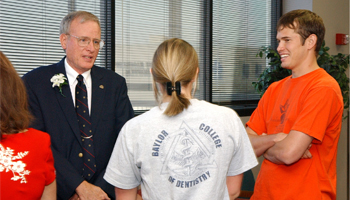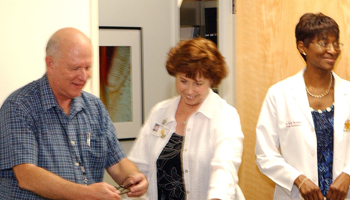Williams & McIntosh celebrate retirement
Dr. James E. McIntosh and Dr. Fred E. Williams, longtime faculty members in the Department of Biomedical Sciences, officially retired from Baylor College of Dentistry this summer, although both have remained in a part-time capacity. Both joined the BCD faculty in 1972.
“Drs. McIntosh and Williams have dedicated themselves wholeheartedly to teaching,” says Dr. Larry Bellinger, Regents professor and associate dean for research and graduate studies, who has been their colleague on the faculty since 1976. “Over the years they have spent thousands of hours one on one with the students.”
McIntosh’s expertise in anatomy and histology has benefited firstyear dental students for years. “Working with the students is definitely my favorite aspect of my BCD career,” he says.
He began teaching in gross anatomy as well as histology in the early 1990s, and welcomed the opportunity to teach in both disciplines, for which he was originally trained.

“Jim is an excellent teacher,” says Williams.
“He enjoyed the direct contact with the students and was very interested in seeing them learn. In fact, his dedication is one of his major contributions.”
Another of McIntosh’s accomplishments is the creation of a series of instructional videotapes covering general and oral histology.
Williams’ focus on physiology has been put to use through basic science courses and labs for dental and dental hygiene students. He currently serves as course director for a two-semester biomedical sciences course for dental hygiene students that integrates biochemistry, histology, physiology and anatomy.
“Fred is colorful and animated in his lectures,” says Dr. Brendan Wong, associate professor of biomedical sciences, who has worked alongside Williams in physiology for 22 years, including collaborating to develop a national board review on CD. “He’s also very versatile in his knowledge of anatomy as well as physiology.”
McIntosh affectionately known as Dr. Mac and Williams are known for their open-door policy with students.
“They are very approachable, and the students are extremely comfortable in coming up to their offices to ask questions,” says Bellinger. “Both of them have made an impact in biomedical sciences instruction at BCD by improving the quality of teaching in this area.”

A little friendly ribbing is commonplace between the two: “We give each other a hard time,” says McIntosh. “Somebody’s got to keep that troublemaker in line.”
Dr. Robert Hinton, professor and interim chair of biomedical sciences, points out that while they share a careerlong devotion to teaching “that is highly atypical among more contemporary faculty hires,” the two have contrasting personalities and personal habits.
“Fred is outgoing and the ultimate packrat (anyone need a physiology handout from 1972?) whereas Jim is more reserved and a ‘neatnik’ dating from his days in the Navy.”
Nevertheless, they have long been mainstays of the biomedical sciences teaching effort, says Hinton. “Their large number of student contact hours have enabled many young, research-oriented faculty to increase their teaching effort gradually, thereby affording them time in their initial years to establish their labs and research program.
“At the same time, BCD students have benefited enormously from the continuity and integration produced by veteran faculty who teach in multiple courses and have teaching as their primary focus,” continues Hinton. “The department faculty, students and staff hope that Dr. Mac and Fred will continue to teach on a part-time basis as long as they wish!”